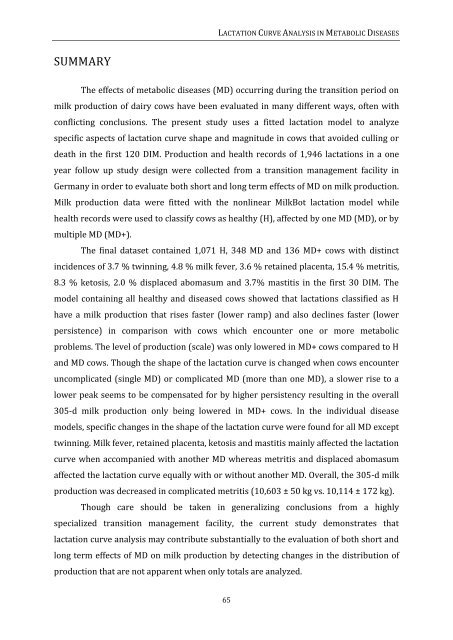view - Department of Reproduction, Obstetrics and Herd Health
view - Department of Reproduction, Obstetrics and Herd Health
view - Department of Reproduction, Obstetrics and Herd Health
You also want an ePaper? Increase the reach of your titles
YUMPU automatically turns print PDFs into web optimized ePapers that Google loves.
LACTATION CURVE ANALYSIS IN METABOLIC DISEASES<br />
SUMMARY<br />
The effects <strong>of</strong> metabolic diseases (MD) occurring during the transition period on<br />
milk production <strong>of</strong> dairy cows have been evaluated in many different ways, <strong>of</strong>ten with<br />
conflicting conclusions. The present study uses a fitted lactation model to analyze<br />
specific aspects <strong>of</strong> lactation curve shape <strong>and</strong> magnitude in cows that avoided culling or<br />
death in the first 120 DIM. Production <strong>and</strong> health records <strong>of</strong> 1,946 lactations in a one<br />
year follow up study design were collected from a transition management facility in<br />
Germany in order to evaluate both short <strong>and</strong> long term effects <strong>of</strong> MD on milk production.<br />
Milk production data were fitted with the nonlinear MilkBot lactation model while<br />
health records were used to classify cows as healthy (H), affected by one MD (MD), or by<br />
multiple MD (MD+).<br />
The final dataset contained 1,071 H, 348 MD <strong>and</strong> 136 MD+ cows with distinct<br />
incidences <strong>of</strong> 3.7 % twinning, 4.8 % milk fever, 3.6 % retained placenta, 15.4 % metritis,<br />
8.3 % ketosis, 2.0 % displaced abomasum <strong>and</strong> 3.7% mastitis in the first 30 DIM. The<br />
model containing all healthy <strong>and</strong> diseased cows showed that lactations classified as H<br />
have a milk production that rises faster (lower ramp) <strong>and</strong> also declines faster (lower<br />
persistence) in comparison with cows which encounter one or more metabolic<br />
problems. The level <strong>of</strong> production (scale) was only lowered in MD+ cows compared to H<br />
<strong>and</strong> MD cows. Though the shape <strong>of</strong> the lactation curve is changed when cows encounter<br />
uncomplicated (single MD) or complicated MD (more than one MD), a slower rise to a<br />
lower peak seems to be compensated for by higher persistency resulting in the overall<br />
305-d milk production only being lowered in MD+ cows. In the individual disease<br />
models, specific changes in the shape <strong>of</strong> the lactation curve were found for all MD except<br />
twinning. Milk fever, retained placenta, ketosis <strong>and</strong> mastitis mainly affected the lactation<br />
curve when accompanied with another MD whereas metritis <strong>and</strong> displaced abomasum<br />
affected the lactation curve equally with or without another MD. Overall, the 305-d milk<br />
production was decreased in complicated metritis (10,603 ± 50 kg vs. 10,114 ± 172 kg).<br />
Though care should be taken in generalizing conclusions from a highly<br />
specialized transition management facility, the current study demonstrates that<br />
lactation curve analysis may contribute substantially to the evaluation <strong>of</strong> both short <strong>and</strong><br />
long term effects <strong>of</strong> MD on milk production by detecting changes in the distribution <strong>of</strong><br />
production that are not apparent when only totals are analyzed.<br />
65









